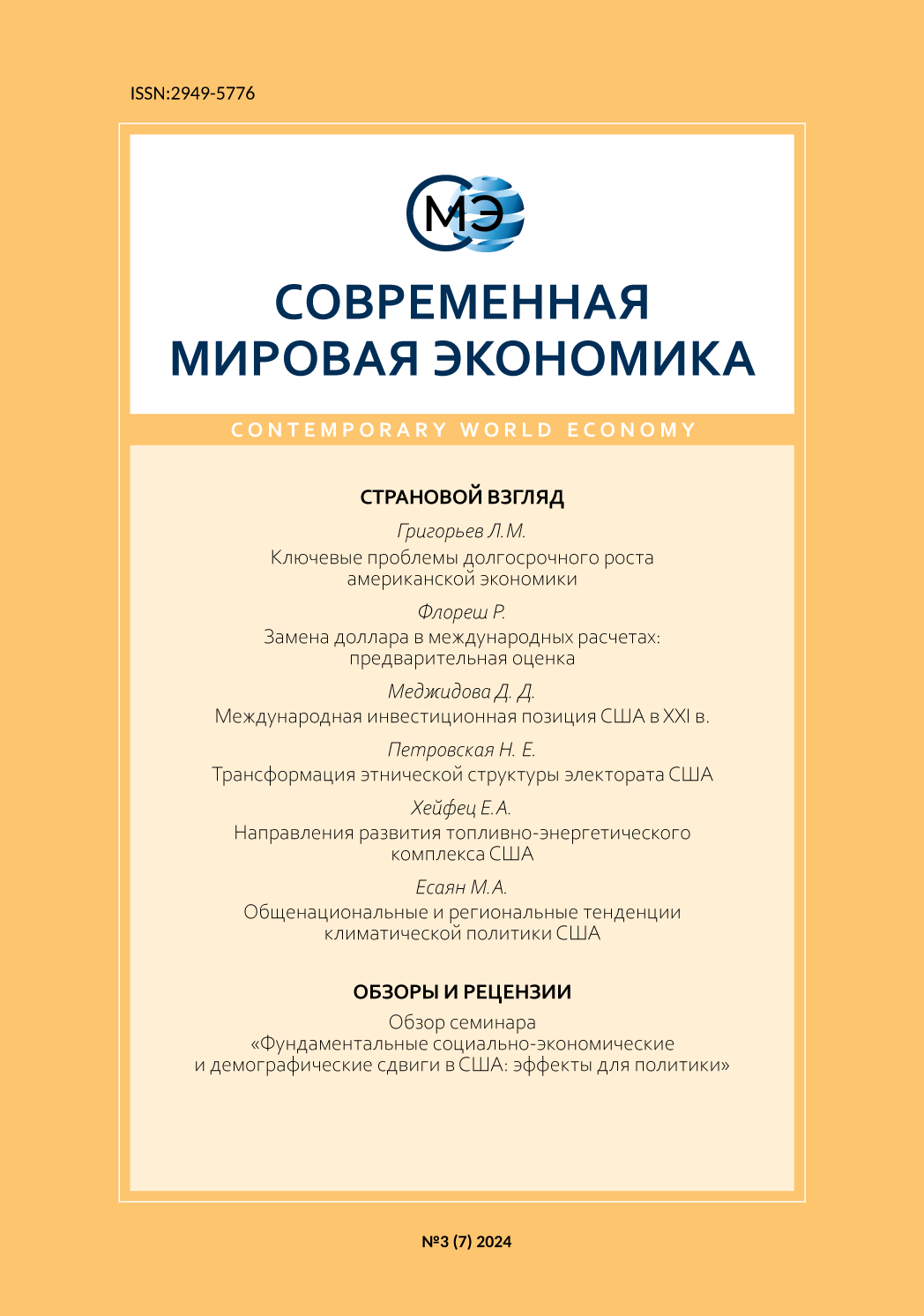Общенациональные и региональные тенденции климатической политики США
Аннотация
США активны в глобальной климатической повестке, но страна остается вторым по объему эмитентом выбросов парниковых газов в мире, а также занимает второе место по объемам производства и потребления энергии. Климатическая политика США характеризуется дискретностью и нестабильностью, что связано со сменой президентских администраций, принадлежащих к различным политическим партиям.
В стране достигнут значительный прогресс в использовании альтернативных источников энергии и снижении общего объема выбросов, однако динамика и характер внедрения возобновляемой энергетики существенно различаются между штатами, фрагментируя усилия на общенациональном уровне. Различия в экономических приоритетах и доступе к энергетическим ресурсам нередко перевешивают влияние политической конъюнктуры, при этом ни экономический рост, ни партийная принадлежность не оказывают решающего влияния на снижение выбросов. Это соответствует исторической тенденции, в рамках которой сокращение выбросов определяется в большей степени наличием природных ресурсов, структурой экономики и технологическими возможностями отдельных штатов, нежели климатической политикой. Ключевыми барьерами на пути к декарбонизации остаются преобладание деловых интересов, медленные темпы реализации мер по борьбе с изменением климата и неамбициозный подход к ним как на национальном, так и на региональном уровне.
Скачивания
Литература
Aldy, J. E., 2017. Real world headwinds for Trump climate change policy. Bulletin of the Atomic Scientists. 2017. pp.1–6.
Biniaz, S., 2018. What Happened to Byrd–Hagel? It’s Curious Absence from Evaluations of the Paris Agreement. Sabin Center for Climate Change Law, Columbia Law School. pp.1–17.
Bonnet, P. et al., 2024. Party affiliation, economic interests and U.S. governors’ renewable energy policies. Energy Economics. Vol. 130(C). pp.1–22.
Borger, J., 2001. Bush kills global warming treaty. The Guardian. 2001. March 29. Available at: https:www.theguardian.com/environment/2001/mar/29/globalwarming.usnews
Broder, J. M., 2009. New Standard Links Mileage and Gas Emissions. The New York Times. September 16. Available at: https:www.nytimes.com/2009/09/16/business/energy-environment/16cars.html
Cefaratti-Bertin, S., 2024. Renewable Energy Goals Are Unattainable by 2050. Baylor University Media & Public Relations. Available at: https:news.web.baylor.edu/news/story/2024/renewable-energy-goals-are-unattainable-2050
Clean Energy States Alliance. Table of 100% Clean Energy States. Available at: https:www.cesa.org/projects/100-clean-energy-collaborative/guide/table-of-100-clean-energy-states/
Dawson, B., 2003. The politics of energy: Coal and Bush’s greenhouse-gas policy. The Center for Public Integrity. Available at: https:publicintegrity.org/environment/the-politics-of-energy-coal-and-bushs-greenhouse-gas-policy/
EIA (1). Energy-Related Carbon Dioxide Emissions by State, 2005–2016. pp.1–29. Available at: https:www.eia.gov/environment/emissions/state/analysis/pdf/stateanalysis.pdf
EIA (2). Energy-Related CO2 Emission Data Tables. Available at: https:www.eia.gov/environment/emissions/state/
EIA (3). Louisiana Profile Overview. Available at: https:www.eia.gov/state/?sid=LA
EIA (4). Monthly Energy Review. Available at: https:www.eia.gov/energyexplained/us-energy-facts/
EIA (5). State Energy Data System (SEDS): 1960-2022 (complete). Available at: https:www.eia.gov/state/seds/seds-data-complete.php?sid=US
EIA (6). West Virginia State Energy Profile. Available at: https:www.eia.gov/state/print.php?sid=WV
EIA (7). Wyoming Profile Analysis. Available at: https:www.eia.gov/state/analysis.php?sid=WY
Energy Institute, 2024. Statistical Review of World Energy. Available at: https:www.energyinst.org/statistical-review
French, M. J., 2022. New York passes sweeping plan to reduce emissions and ‘lead the way on solving climate change’. Politico. December 19. Available at: https:www.politico.com/news/2022/12/19/new-york-emissions-climate-change-00074600
General White House Bibliography: The White House President Barack Obama Climate Change and President Obama’s Action Plan. 2015. Available at: https:obamawhitehouse.archives.gov/president–obama–climate–action–plan
Gurney, R.M. et al., 2021. The influences of power, politics, and climate risk on US subnational climate action. Environmental Science & Policy. Vol. 116. pp.96–113.
Kovalev, Yu. Yu., 2022. Climate Policy of the United States: Features of Evolution and the Current State. History and Modern Perspectives. Vol. 4. No 1. pp.24-32 (in Russian).
Lynch, A. et al., 2021. The United States Sustainable Development Report 2021. New York: SDSN. pp.1–64.
National Conference of State Legislatures. State & Legislative Partisan Composition. 2023. Available at: https:www.ncsl.org/about-state-legislatures/state-partisan-composition
NationMaster, 2019. United States Vehicles in Use. Available at: https:www.nationmaster.com/nmx/timeseries/united-states-vehicles-in-use
New York State Climate Action Council. Scoping Plan, December 2022: Executive Summary. Available at: https:climate.ny.gov/-/media/Project/Climate/Files/Chapter1ExecutiveSummary.pdf
Noor, D., 2023. California to require big firms to reveal carbon emissions in first law of its kind. The Guardian. October 9. Available at: https:www.theguardian.com/us-news/2023/oct/09/california-carbon-emissions-law
Raghutla, C. et al., 2021. Financing clean energy projects: new empirical evidence from major investment countries. Renewable Energy. Vol. 169. pp.231–241.
Ren X. et al., 2020. Nexus between green finance, non-fossil energy use, and carbon intensity: empirical evidence from China based on a vector error correction model. Journal of Cleaner Production. Vol. 277. 122844. pp.1–12.
Ritchie, H., 2024. Republican states are going strong on solar and wind, but not for the climate. Sustainability by Numbers. Available at: https:www.sustainabilitybynumbers.com/p/red-states-renewables
Royden, A., 2002. U.S. Climate Change Policy Under President Clinton: A Look Back. Golden Gate University Law Review. Vol. 32. No. 4. Article 3. pp.415–478.
Rudolph, M. et al., 2023. The Impact of Renewable Energy Tax Incentives on Electricity Pricing in Texas. Applied Sciences. 13(14):8532. pp.17–19.
Rystad Energy, 2023. Renewables and Power Post-Inflation Reduction Act: One year later. Whitepaper In-depth analysis on overcoming challenges post-Inflation Reduction Act. pp.1–15.
Senate Democrats. The Inflation Reduction Act of 2022: Summary. p.1.
Shepardson, D., 2020. Trump finalizes rollback of Obama-era vehicle fuel efficiency standards. Reuters. Available at: https:www.reuters.com/article/us-usa-autos-emissions-idUSKBN21I25S#:~:text=Under%20the%20Obama%2Dera%20rules,mpg%20under%20the%20Obama%20rules
Silverman-Roati, K., 2021. U.S. Climate Litigation in the Age of Trump: Full Term. The Sabin Center for Climate Change Law. pp.1–142.
Statista (1). Automobile registrations in the United States in 2021, by state [Graph]. Available at: https:www.statista.com/statistics/196010/total-number-of-registered-automobiles-in-the-us-by-state/
Statista (2). Net electricity generation in the United States from 1990 to 2023, by energy source (in terawatt-hours). Available at: https:www.statista.com/statistics/220174/total-us-electricity-net-generation-by-fuel/
The White House, 1965. Restoring the Quality of Our Environment. Report of the Environment Pollution Panel President’s Science Advisory Committee.
UN DESA. Sustainable Development: The 17 Goals. Available at: https:sdgs.un.org/goals
UNFCCC, 2021. The United States of America Nationally Determined Contribution, Reducing Greenhouse Gases in the United States: A 2030 Emissions Target. pp.1–23.
Waxman, O. B., 2019. Reagan Administration Officials at First Dismissed the Ozone Hole. Here’s What Changed. TIME. Available at: https:time.com/5564651/reagan-ozone-hole/
Copyright (c) 2024 Марианна Армановна Есаян

Это произведение доступно по лицензии Creative Commons «Attribution-NonCommercial-NoDerivatives» («Атрибуция — Некоммерческое использование — Без производных произведений») 4.0 Всемирная.



.jpg)

